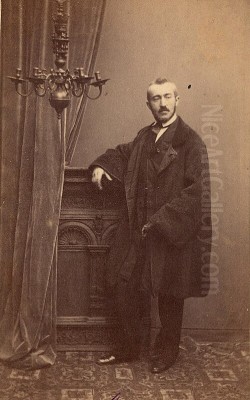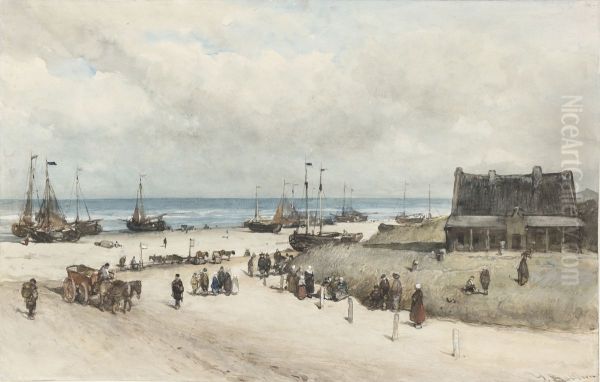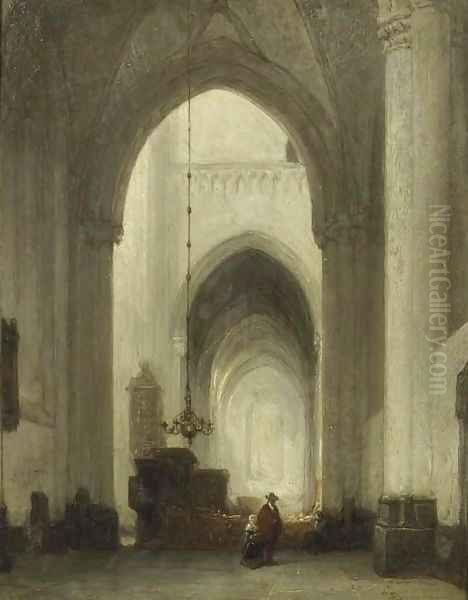
Johannes Bosboom stands as a significant figure in nineteenth-century Dutch art. A prominent painter and watercolorist associated with the Hague School, his legacy is deeply intertwined with his evocative depictions of church interiors, masterful handling of light, and contributions to the artistic landscape of his time. His life and work offer a fascinating window into the evolution of Dutch painting during a period of renewed national artistic identity.
Early Life and Artistic Formation
Born in The Hague on February 18, 1817, Johannes Bosboom demonstrated artistic inclinations from a young age. His formal artistic journey began around the age of fourteen when he entered the tutelage of Bartholomeus van Hove. Van Hove was a respected painter known for his townscapes and church interiors, providing Bosboom with a solid foundation in perspective, architectural rendering, and the prevailing Romantic sensibilities of the era.
Within Van Hove's studio, Bosboom was not merely a passive student. He actively participated in the workshop's activities, collaborating with his master's son, Hubertus van Hove. Together, they worked on creating scenic designs for the Royal Theatre in The Hague (Koninklijke Schouwburg). This early experience likely honed Bosboom's skills in managing large compositions and understanding the interplay of light and space, albeit in a theatrical context.
Formal Education and Early Travels
Parallel to his apprenticeship, Bosboom pursued formal education at the Hague Academy of Art (Academie van Beeldende Kunsten). He attended the academy between 1831 and 1835, and again from 1839 to 1840. This period provided him with structured training in drawing and other academic disciplines, further refining his technical abilities. It was also a crucial time for forging connections with fellow artists who would become important figures in the Dutch art world.
During his academy years, Bosboom befriended artists such as Anthonie Waldorp (also cited as Antonie Wolph Vandevelde in some sources) and Wijnand Nuyen. Nuyen, a highly talented painter whose life was cut tragically short, was known for his Romantic landscapes and cityscapes. His influence, along with that of Van Hove, shaped Bosboom's early artistic direction. Another significant early contact was Hans van der Weerden, whom he met at the academy in 1831.

Travel played a role in broadening Bosboom's horizons. In 1835, he undertook a journey to Germany with fellow artist Samuel Verveer. This trip exposed him to different landscapes and architectural styles. It was during this period, influenced by his travels and interactions, particularly the noted influence of Hans van der Weerden, that Bosboom began to solidify his artistic voice. An early work, the watercolor `Water View of the Mosel Bridge in Koblenz`, stems from this period, showcasing his developing skill in capturing atmosphere and architectural elements.
The Hague School and Artistic Milieu
Johannes Bosboom is intrinsically linked to the Hague School, a movement that emerged in the Netherlands roughly between 1860 and 1890. While Bosboom's career began earlier, his mature work aligns closely with the school's ethos. The Hague School artists sought to break away from the idealized historical and biblical scenes of Romanticism, turning instead towards realistic depictions of the Dutch landscape, peasant life, and coastal scenes. They emphasized mood, atmosphere, and the effects of light, often employing a palette characterized by subtle grays and earth tones.
Bosboom was a respected member of this artistic circle. He was associated with key figures of the movement, including Willem Maris, known for his luminous landscapes with cattle; Johannes Hendrik Weissenbruch, celebrated for his expansive, light-filled watercolors of Dutch polders and skies; and Hendrik Willem Mesdag, famous for his seascapes, particularly his monumental Panorama Mesdag. These artists, along with others like Anton Mauve and Jozef Israëls, formed a vibrant community, often interacting through artists' societies like the Pulchri Studio in The Hague, where Bosboom was also active.
His connection with Bartholomeus van Hove remained significant, as Van Hove was also a teacher to Weissenbruch, creating a lineage within the Hague artistic community. Bosboom's friendship with Anthonie Waldorp (Vandevelde) continued, with Waldorp becoming a supporter and collector of Bosboom's work, indicating the mutual respect among these contemporaries.
Mastery of Church Interiors
While the Hague School is often associated with landscapes and seascapes, Bosboom carved a unique niche with his specialization in church interiors. He possessed an extraordinary ability to capture the specific atmosphere of these sacred spaces – the quiet reverence, the vastness of the architecture, and, most importantly, the play of light filtering through stained glass windows or illuminating aged stone pillars.

His paintings are not mere architectural records; they are poetic interpretations of space and light. Bosboom masterfully used subtle gradations of tone and color to convey depth and volume. Sunlight streams into shadowy interiors, highlighting textures of wood, stone, and fabric, creating focal points and leading the viewer's eye through the composition. His works often evoke a sense of timelessness and spiritual contemplation. He frequently depicted famous Dutch churches, such as the Oude Kerk (Old Church) in Amsterdam, capturing their historical weight and unique character.
His approach evolved over time. Early works might show more detailed rendering, influenced by Romanticism. However, especially in his later watercolors, his style became broader and more suggestive, focusing on the overall impression of light and atmosphere rather than minute detail. This aligns with the later phases of the Hague School and anticipates aspects of Impressionism, prioritizing the sensory experience over precise documentation.
Representative Works
Several works stand out in Bosboom's oeuvre, illustrating his thematic concerns and stylistic strengths:
`Church Services in the Cathedral of Trier`: This title suggests a work capturing not just the architecture of the grand German cathedral but also the human element of worship within it. One can imagine Bosboom focusing on the interplay of light within the vast Gothic or Romanesque space, perhaps contrasting the scale of the building with the gathered congregation.
`De Sjoel`: "Sjoel" is a Yiddish/Dutch term for a synagogue. This work indicates Bosboom's interest extended beyond Christian churches to other places of worship. It likely depicts the interior of a synagogue, perhaps in The Hague or Amsterdam, offering a different architectural setting and potentially a distinct quality of light and atmosphere compared to his cathedral paintings.
`Old Church in Amsterdam`: A recurring subject, this likely refers to multiple works depicting the famous Oude Kerk. These paintings would showcase his ability to render the specific character of this historic building, focusing on its Gothic architecture and the way light interacts with its interior spaces.
`Water View of the Mosel Bridge in Koblenz`: As mentioned, this early watercolor demonstrates his skill in landscape and architectural views from his travels, capturing the picturesque quality of the German town and river.
`The Beach at Scheveningen`: Although primarily known for interiors, Bosboom also painted landscapes and coastal scenes, aligning him with his Hague School contemporaries. This work, dated 1873, would likely depict the famous beach near The Hague, possibly featuring fishing boats, dunes, and the atmospheric sky characteristic of the school. Interestingly, this specific painting has reportedly been subject to attribution debates, highlighting the complexities that can sometimes arise in art historical scholarship.
Watercolor Technique

Bosboom was particularly renowned for his skill as a watercolorist. Many critics and art historians consider his watercolors to be even more expressive and masterful than his oil paintings. The transparency and fluidity of watercolor lent themselves perfectly to his preoccupation with light. He could achieve remarkable luminosity and atmospheric effects using washes of color, allowing the white of the paper to shine through, representing highlights and the diffusion of light in a way that is often harder to achieve in oil.
His watercolors often possess a freshness and spontaneity, even when depicting complex architectural interiors. The medium allowed for a more direct and perhaps more personal response to the subject, capturing fleeting effects of light and shadow with apparent ease. His mastery in this medium solidified his reputation as one of the leading Dutch watercolorists of his generation.
Later Life and Interactions
Bosboom remained an active figure in the art world throughout his life. His interactions extended beyond his immediate Hague School circle. An anecdote recorded involves the writer Eduard Douwes Dekker, better known by his pen name Multatuli, famous for his novel Max Havelaar. Reportedly, during a walk, Bosboom visited Multatuli's residence and was notably struck by the long hair of Multatuli's wife, Nonni (Tine). While a minor incident, it offers a glimpse into Bosboom's encounters with other prominent cultural figures of the time.
His life was not solely confined to the studio. He demonstrated civic engagement, serving as a councilman in the city of Groningen in 1862. This suggests a broader interest in the society around him, beyond the confines of artistic creation.
The potential influence or connection, however indirect, to the legacy of the great Dutch Golden Age master Johannes Vermeer has also been noted. While separated by centuries, Vermeer's unparalleled mastery of light and interior scenes provides a historical precedent. Whether Bosboom consciously studied Vermeer or simply shared a Dutch sensibility for light and domestic or sacred space, the comparison highlights Bosboom's place within a longer tradition of Dutch art. The text mentions a possible connection via Vermeer's descendants, though the nature of this connection remains unspecified.
Stylistic Evolution and Controversy
As mentioned, Bosboom's style was not static. He navigated the transition from the detailed, often narrative focus of Romanticism towards a more atmospheric, light-focused realism characteristic of the Hague School, and even further towards a looser, more suggestive handling in his later works, particularly watercolors. This evolution, described as a move towards simplification and capturing the "essence" of the scene, might have sparked discussion or even controversy among contemporaries accustomed to more traditional finishes. Such shifts often challenge established norms, but they also demonstrate an artist's willingness to grow and experiment throughout their career.
Legacy and Influence
Johannes Bosboom passed away in The Hague on September 14, 1891. He left behind a significant body of work that continues to be admired for its technical skill and profound sensitivity to atmosphere and light. He is considered one of the pillars of the Hague School, bringing a unique focus on architectural interiors to a movement more commonly associated with outdoor scenes.
His influence extended to subsequent artists. Hendrik Willem Mesdag, a fellow Hague School painter and a major figure in the Dutch art scene (known also as a collector and founder of the museum bearing his name), was profoundly influenced by Bosboom. This demonstrates the respect Bosboom commanded among his peers and his role in shaping the direction of Dutch art.
His reputation endured after his death. A commemorative exhibition was held in 1917, marking the 25th anniversary of his passing, indicating his continued importance in the eyes of the art establishment and the public. While perhaps not as internationally famous as some of his Dutch predecessors or contemporaries like Van Gogh (who collected Hague School prints), Bosboom remains a crucial figure for understanding nineteenth-century Dutch art, particularly the nuances of the Hague School and the enduring power of depicting sacred spaces through the transformative lens of light. His works reside in major Dutch museums, including the Rijksmuseum in Amsterdam and the Kunstmuseum Den Haag, securing his place in the annals of art history.